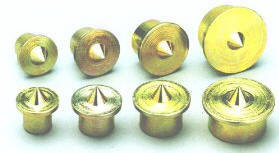Today we're going to discuss transfer punches.

$10 set from Harbor Freight
One trick that some people know is that if you have a drill bit set you also have a fairly accurate set of setup bars. OK, so they're round but you can use the shank end of a 1/8" drill bit to space an item exactly 1/8" away from a fence or set a 1/8" gap between two parallel boards you are fastening down.
The transfer punch is one step better - its like a brad point drill bit set with no flutes, just a straight rod. The sets usually come in 28- pieces, that is 28 rods from 3/32 to 1/2" by 1/64th in an index stand. And they're cheap - A quick look on google shows them from $9.99 at HF to about $20 (although you can spend $100 for a set from Starrett) which are quite accurate.
Not having the cutting flutes on them makes them easier to handle without slicing your fingers and obviously cheaper to make than drill bit sets. It also makes them fully smooth - the whole length can be used for spacing - and better for indexing.
But one of the best things about them is that they are intended for something else: and that is to mark the center of holes between a template piece and a workpiece.
The template can be the your prototype or a item you want to match the holes in. You can make matching holes in the workpiece.
Lay your template on the workpiece and hold in position so it doesn't shift while you do your transfers. try several punches from the set until you find one that matches the hole you want to drill. They mostly claim these are made .0025" undersize (that 2-1/2 thousandths) so they will be a slipfit into the intended hole size.
The punch has a flat, blunt end and a flat end with a conical protrusion in the center. This end should go into the hole in the template and use a small hammer (or just hand force on wood) on the blunt end to mark the workpiece. Since the punch is a tight fit and the point is in the center, you have now marked dead center of the location. This is better than just sticking a smaller drill into a bigger hole and hoping it starts in the center. or marking a circle with your pencil and then trying to start a hole in its exact center by guesstimation.
you can drill a hole the same size as the punch to match the hole in the template, or you can drill a smaller pilot hole for wood screws.
So anyway, a definite shop helper for more accurate work for $10.

$10 set from Harbor Freight
One trick that some people know is that if you have a drill bit set you also have a fairly accurate set of setup bars. OK, so they're round but you can use the shank end of a 1/8" drill bit to space an item exactly 1/8" away from a fence or set a 1/8" gap between two parallel boards you are fastening down.
The transfer punch is one step better - its like a brad point drill bit set with no flutes, just a straight rod. The sets usually come in 28- pieces, that is 28 rods from 3/32 to 1/2" by 1/64th in an index stand. And they're cheap - A quick look on google shows them from $9.99 at HF to about $20 (although you can spend $100 for a set from Starrett) which are quite accurate.
Not having the cutting flutes on them makes them easier to handle without slicing your fingers and obviously cheaper to make than drill bit sets. It also makes them fully smooth - the whole length can be used for spacing - and better for indexing.
But one of the best things about them is that they are intended for something else: and that is to mark the center of holes between a template piece and a workpiece.
The template can be the your prototype or a item you want to match the holes in. You can make matching holes in the workpiece.
Lay your template on the workpiece and hold in position so it doesn't shift while you do your transfers. try several punches from the set until you find one that matches the hole you want to drill. They mostly claim these are made .0025" undersize (that 2-1/2 thousandths) so they will be a slipfit into the intended hole size.
The punch has a flat, blunt end and a flat end with a conical protrusion in the center. This end should go into the hole in the template and use a small hammer (or just hand force on wood) on the blunt end to mark the workpiece. Since the punch is a tight fit and the point is in the center, you have now marked dead center of the location. This is better than just sticking a smaller drill into a bigger hole and hoping it starts in the center. or marking a circle with your pencil and then trying to start a hole in its exact center by guesstimation.
you can drill a hole the same size as the punch to match the hole in the template, or you can drill a smaller pilot hole for wood screws.
So anyway, a definite shop helper for more accurate work for $10.

 Loring in Katy, TX USA
Loring in Katy, TX USA



Comment